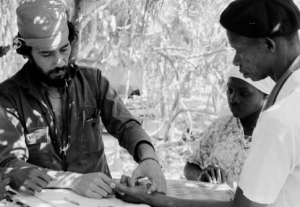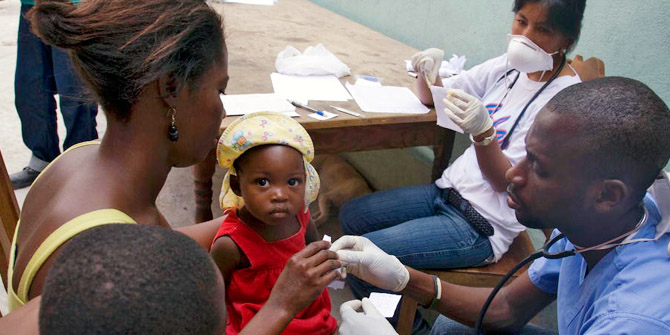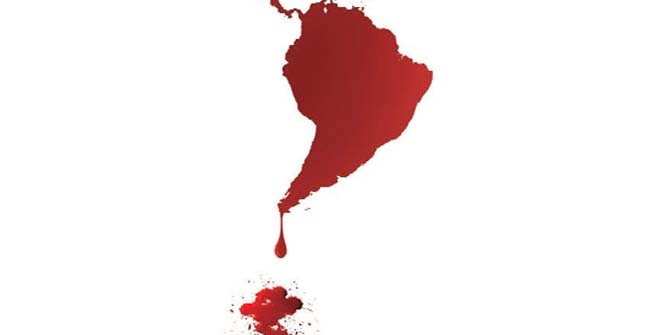 After Castro’s death and with profound political and economic change across the Americas, Gail Hurley asks, what future for Cuba’s medical internationalism?
After Castro’s death and with profound political and economic change across the Americas, Gail Hurley asks, what future for Cuba’s medical internationalism?
The recent death of Fidel Castro at age 90 prompted a flurry of commentary simultaneously proclaiming the former Cuban leader a hero or a tyrant. Biographers and commentators will no doubt pore over his tenure and legacy for years to come but few will challenge the view that Castro transformed his country and reshaped global political relations during his lifetime. In so doing, the small island nation of just over 11 million people punched well above its weight in the international arena.
One way in which Cuba has consistently ‘punched above its weight’ is its extraordinary global medical record. John Kirk, a Canadian Professor and authority on Latin America, describes Cuba’s medical internationalism as ‘the world’s best kept secret.’ He puts the number of Cuban medical personnel at over 38,000 in over 60 countries around the world with over 20 per cent of Cuba’s doctors working overseas. To put this in context, Cuba (population 11.4 million) has more medical personnel working abroad than the World Health Organization and the G7 countries combined. In addition, Cuba has the largest medical school in the world – the Latin America School of Medicine (ELAM) founded in 1999 – which has over 8,000 students enrolled, the vast majority from developing nations. The school also operates positive discrimination towards families with limited means and towards disadvantaged communities such as the black and indigenous communities of Central and South America.

The tradition of providing medical assistance dates back to the first years following Cuba’s 1959 revolution. The island’s new government soon began to provide emergency medical assistance to countries affected by disasters or armed conflicts. In 1962, just a few years after the revolution and when health professionals were sorely needed at home, Cuba sent 56 doctors to Algeria to support the newly independent nation with its medical needs.
Since then, Cuba’s international medical assistance programme has mushroomed. The medical relief operations after Hurricane Mitch struck Central America in 1998 were pivotal. Since 2013, over 11,000 health professionals have served in Brazil under the country’s ‘Mais Medicos’ programme which provides health services to underserved regions and communities. Cuba also has a longstanding health programme in Haiti and over 15,000 Haitians have benefited from Cuban health training initiatives. Indeed, a hallmark of Cuban medical cooperation is that doctors are there for the long-run; they do not engage in so-called ‘medical tourism’. Most recently, Cuba deployed over 250 doctors and nurses to West Africa to join the international effort to fight the Ebola disease outbreak in Guinea, Liberia and Sierra Leone. Cuban doctors have carried out over 3 million eye operations in 33 countries, mostly in Latin America and the Caribbean, funded in part by Cuba’s close ally Venezuela.
But like all international cooperation activities, they cannot be considered in isolation from other political and economic forces at play. Cuba’s international health assistance programme must be viewed as one strategy that has aimed to break the United States’ attempts to isolate the country internationally. Medical internationalism is in this context a tool of ‘soft diplomacy’. Cuba’s provision of medical personnel to many socialist states around the world over the years is also no accident. The recent Cuban-Venezuelan collaboration meanwhile has both political and economic dimensions; the relationship is a means to tackle the United States’ dominance in Latin America while the ‘Oil for Doctors’ programme provides for deeply subsidised oil exports from Venezuela in return for doctors, teachers and military advisers from Cuba. Additionally, Cuba reportedly earns some U$8 billion a year in revenues from professional services carried out by its doctors and nurses overseas since the authorities collect a portion of the incomes earned by Cuban workers abroad. Cuba’s international medical assistance programme is therefore one of the island’s largest exports.
But as I’ve said elsewhere, political, economic, security and moral objectives are at play with any donor’s international aid activities, and indeed some, such as the UK (among others), have recently reasserted the role that development aid can play in leveraging and negotiating trade deals.

There has been much academic discussion over recent years about the rise of so-called ‘South-South Cooperation’ and the role that ‘emerging donors’ (especially China) are increasingly playing in the international development arena. In these discussions, the contribution of Cuba is often overlooked. Over the past 50+ years, Cuba has consistently used the export of its medical personnel as a powerful and far-reaching tool of health diplomacy. The island nation has built good will and improved its standing with countries around the world during its years of isolation. Its national health system is the envy of many countries in the developing world and the interventions of its health professionals have saved (and continue to save) millions of lives worldwide. Kirk describes Cuba’s medical internationalism as a ‘flag-bearer of Cuba’s commitment to accessible and sustainable healthcare, free to all (especially the marginalized).’ For such a small country in difficult economic conditions of its own, it is an extraordinary humanitarian record.
Looking forward, what future for Cuba’s medical internationalism? The international development cooperation arena is increasingly crowded and some of Cuba’s key partners, such as Venezuela and Brazil, are experiencing profound political, economic and social instability. This is combined with a Trump Presidency in the US that has threatened to ‘close doors’ on already very tentative ties with Havana.
Cubans will probably tell you they have weathered far more severe storms over the last fifty years. Cuba has also very much carved out a niche for itself in international development cooperation; Cuban medical professionals continue to inspire and serve in some of the world’s most remote and undeserved places in the world. There is no indication that Cuba’s commitment to social equality and internationalism will wane any time soon.
Notes:
• The views expressed here are of the authors rather than the Centre or the LSE
• This article was originally published at speri.comment.
• Please read our Comments Policy before commenting





